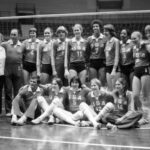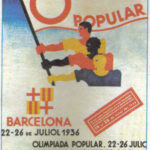This summer, in London, will see the start of the Games of the 30th Olympiad. When the Opening Ceremonies begin, the question that viewers will be asking is, “Who will light the Olympic Cauldron?” While spectators from around the world will have to wait until late July for the answer to that question, I will be looking forward to how the flame is lit inside Olympic Stadium. Since watching Olympic gold medal winner decathlete Rafer Johnson light the Cauldron at the 1984 Olympics in Los Angeles, I have been fascinated with how the creators of the opening pageant come up with the myriad of ways to light the Olympic flame. What follows are, in my opinion, the five best torch lighting moments from the Summer Olympics.
1980 – MOSCOW: FIRST SURPRISE
From 1928 in Amsterdam to 1976 in Montreal, the lighting of the Cauldron was a fairly straightforward affair. A person approaches the final lighting place, raises high the Torch for all to see, and then lowers it where the flame is lit. The Opening Ceremonies in Moscow saw the first time that a gimmick was used to assist in the lighting of the Cauldron. As Olympic basketball gold medalist Sergei Belov runs in Central Lenin Stadium with the Torch, a pathway connecting the track to the Cauldron appears allowing Belov to run over the heads of the athletes. From that Games forward, there would always be some new way to light the Cauldron.
1964 – TOKYO: MOST SYMBOLIC
Olympic athletes have often been used to light the Cauldron. Examples include Paavo Nurmi and Hannes Kolehaminen at the 1956 Helsinki Games, Nikolaos Kaklamanakis in Athens (2004), and Li Ning in Beijing (2008). For the 1964 Summer Games in Tokyo, the organizers decided to go the symbolic route. The person chosen to be the last person to run with the Olympic Torch was Yoshinori Sakai who was born in Hiroshima, Japan, on August 6, 1945, which was the same day that the atomic bomb was dropped over that city. His selection showcased Japan’s postwar emergence as a country of peace.
2000 – SYDNEY: MOST SURPRSING
While she was not the first woman to light the Olympic Cauldron (that honor goes to Enriqueta Basilio at the 1968 Mexico City Games), Australian runner Cathy Freeman is the only person ever to be the final torchbearer and win a gold medal at the same Olympics. Why I consider this torch lighting the most surprising is that after Freeman accepts the torch, she runs up a flight of stairs into a pool of water. There is no hint where she stands of a mechanism to place the flame. Freeman then dips the torch down and, courtesy of a partially submerged ring, the water itself appears to ignite. A ring of fire appears, surrounds Freeman, and ascends to become the Cauldron. Okay, there is a bit of glitch with the mechanism and it takes a bit longer than planned, but the effect is still amazing.
1996 – ATLANTA: MOST CATHARTIC
When Muhammad Ali took the Olympic flame from swimmer Janet Evans in Atlanta during the Opening Ceremonies, it was a wonderful moment in the annals of American sports history. Ali was a gold medal winner in boxing during the 1960 Games in Rome, but that fame did little to protect him from criticism after he publicly refused to serve in the United States military during the Viet Nam War for personal and religious reasons. Ali would be arrested for draft evasion and have his World Heavyweight title stripped. Years later, after regaining the title, retiring, and being diagnosed with Parkinson’s Disease, the boxer known as “The Greatest”, stands atop Centennial Olympic Stadium and takes in the respect and adulation the crowd and television viewers give to him. As NBC’s Bob Costas simply says, “What a moment.”
1992 – BARCELONA: MOST DARING
Every lighting at the Opening Ceremonies, up until 1992, had consisted of a person (or group of people) holding the torch and physically touching it to the Cauldron to set it ablaze. The Barcelona Olympic Games not only saw the first paralympian light the Cauldron, but it is, to my eyes, the most daring, innovative, and spectacular method ever. Spanish archer Antonio Rebello was given the honor of lighting the Olympic Cauldron two hours before the event. After the final torch runner lights Rebello’s arrow, Rebello draws back his bow and launches the flaming projectile over the Cauldron which then erupts into a blaze symbolizing the start of the 25th Olympiad.
This July, I look forward to how the designers of the London Olympics will ignite the Games and our imaginations.





